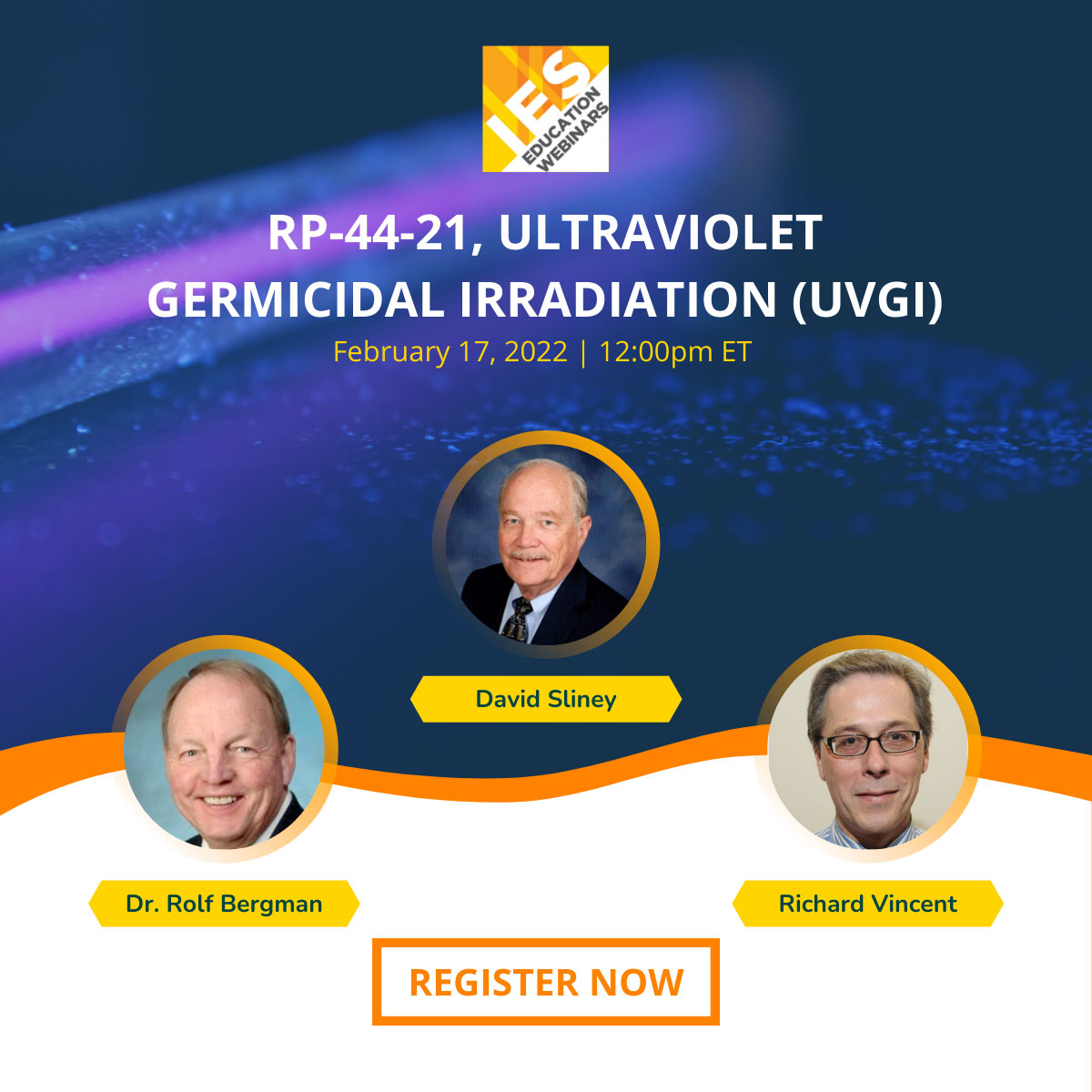-
February 17, 2022
9:00 am - 10:30 am

Historically, germicidal ultraviolet germicidal irradiation (UVGI) dates back more than a century and was widely used in hospitals and public places to reduce infections by inactivating airborne parthenogens in the 1930s – 1950s. Studies from those times demonstrated efficacy, but UVGI use later dropped out of favor in the 1960s after vaccines against a number of childhood diseases, such as polio and measles had been virtually eliminated. Of infectious diseases of significant severity in the developed world only tuberculosis has been without a vaccine and for that reason UVGI has remained in TB clinics – particularly in those countries where TB continues to be a major problem. In these countries, some expertise has been retained. Today with the COVID-19 pandemic, the lessons learned from TB control allow for a ‘rediscovery’ of this technology for use in the current pandemic. Furthermore, the pandemic has greatly accelerated development of UV-C LEDs and other lamp types such as the far-UV-C krypton-chloride (222-nm) lamp to augment the traditional use of low-pressure mercury (254 nm) lamp. Sadly, misconceptions about UVGI, such as a perceived skin cancer risk remain and a lack of understanding of proper safety precautions continue to slow the wide acceptance of UVGI. ANSI/IES RP44 was prepared by the IES Photobiology Committee to better inform all interested lighting specialists as well as those responsible for infectious disease control.
To download RP-44-21, or subscribe to the Lighting Library, visit the IES Webstore.
Please note this is a 90 min webinar, webinar participants are eligible for one (1.5) IES Continuing Education Units (CEUs).
PRESENTERS:
David Sliney
 David Sliney holds a Ph.D. in biophysics and medical physics from University College London, Institute of Ophthalmology. He managed the Laser/Optical Radiation Program at what is now the Army Public Health Center until retirement. He is a faculty associate at the Johns Hopkins School of Public Health. His research interests focus on subjects related to ultraviolet effects, photobiological hazards of intense optical sources and lasers, and optical safety of medical devices. He is chair of the IES Photobiology Committee and was President of the American Society for Photobiology in 2008-2009 and a past Director of CIE Division 6 (Photobiology and Photochemistry) and a past Grum Awardee.
David Sliney holds a Ph.D. in biophysics and medical physics from University College London, Institute of Ophthalmology. He managed the Laser/Optical Radiation Program at what is now the Army Public Health Center until retirement. He is a faculty associate at the Johns Hopkins School of Public Health. His research interests focus on subjects related to ultraviolet effects, photobiological hazards of intense optical sources and lasers, and optical safety of medical devices. He is chair of the IES Photobiology Committee and was President of the American Society for Photobiology in 2008-2009 and a past Director of CIE Division 6 (Photobiology and Photochemistry) and a past Grum Awardee.
Dr. Rolf Bergman
 Dr. Rolf Bergman is currently an independent consultant (sole proprietor) in lighting technology and measurements. After graduating with a Ph.D. in Electrical Engineering in 1972 from the University of Minnesota, Dr. Bergman worked for over twenty-eight years at GE Lighting, all at Nela Park, Cleveland, OH, both as an individual contributor and manager in lamp technology. While at GE Lighting he was involved new product and process development, measurement capability and industry standards. Dr. Bergman was named Chief Scientist, Lamp Technology in 1992, a position he held until retirement in 2001. Currently, among other consulting work, he serves as an assessor of lighting laboratories for accreditation to NVLAP, and accrediting body organized at the National Institute of Standards and Technology (NIST). Dr. Bergman served as President of the CIE/USA National Committee from 11/2003 to 11/2008. He also was the chair of CIE TC 6-47, the group that produced a global standard for photobiological risk evaluation of lamps, now known as IEC 62471 (also CIE E9). He serves as a member of the IESNA Technical Procedures and Photobiology Committee and he is a member of CORM, an industry group that advises NIST on measurement needs in US industry. While at GE he was the author or co-author of 19 US Patents and published about 20 Journal articles with an additional 20 to 30 internal GE reports. In April 2020 he participated in the IES-sponsored webinar on the use of UV disinfection related to the then new Covid-19 pandemic; his focus there was on the source technology. That presentation was published: Photochemistry and Photobiology, 2021, 97: 466–470.
Dr. Rolf Bergman is currently an independent consultant (sole proprietor) in lighting technology and measurements. After graduating with a Ph.D. in Electrical Engineering in 1972 from the University of Minnesota, Dr. Bergman worked for over twenty-eight years at GE Lighting, all at Nela Park, Cleveland, OH, both as an individual contributor and manager in lamp technology. While at GE Lighting he was involved new product and process development, measurement capability and industry standards. Dr. Bergman was named Chief Scientist, Lamp Technology in 1992, a position he held until retirement in 2001. Currently, among other consulting work, he serves as an assessor of lighting laboratories for accreditation to NVLAP, and accrediting body organized at the National Institute of Standards and Technology (NIST). Dr. Bergman served as President of the CIE/USA National Committee from 11/2003 to 11/2008. He also was the chair of CIE TC 6-47, the group that produced a global standard for photobiological risk evaluation of lamps, now known as IEC 62471 (also CIE E9). He serves as a member of the IESNA Technical Procedures and Photobiology Committee and he is a member of CORM, an industry group that advises NIST on measurement needs in US industry. While at GE he was the author or co-author of 19 US Patents and published about 20 Journal articles with an additional 20 to 30 internal GE reports. In April 2020 he participated in the IES-sponsored webinar on the use of UV disinfection related to the then new Covid-19 pandemic; his focus there was on the source technology. That presentation was published: Photochemistry and Photobiology, 2021, 97: 466–470.
Richard Vincent
 Mr. Vincent applies germicidal ultraviolet (GUV) disinfection technology and tools to control the transmission of tuberculosis and other infectious diseases both airborne and surface borne (fomite) or mix-mode, in high-risk settings. During the COVID-19 pandemic he work with a team of virologists, engineers and biodesigners at Mount Sinai and RPI to inactivate SARS-CoV-2 inoculated on respirators to test a UVC system for possible reuse of respirators. He was the project manager and UV lighting specialist for the Tuberculosis Ultraviolet Shelter Study (TUSS), (1997-2004). TUSS—a multidisciplinary, multicenter epidemiological field trial of ultraviolet air cleansing effectiveness formed by St. Vincent’s Hospital and the Harvard School of Public Health (HSPH) advanced UVGI application for airborne disease control in homeless shelters. At the Mount Sinai Hospital, he is working to reduce the rate of hospital-acquired infections (HAIs) by benchmarking the efficacy of various technologies including mobile, whole-room UVC devices for decontamination of surfaces from pathogens such as MRSA, and C. Difficile. He has studied the use of stationary UV units to clean mobile technology, UVC cleansing of mobile technology. He is studying UV LED surface disinfection in the laboratory and then in situ. He has provided technical assistance on GUV projects in India, Myanmar, and Pakistan. Since 2016, Mr. Vincent serves at the Coordinator for the StopTB Partnership working Group: End TB Transmission Initiative (ETTI). He provided expert input on GUV for the WHO Guidelines on tuberculosis infection prevention and control, 2019 update. Mr. Vincent chairs the ASHRAE GCP 37 developing guidelines for the application of upper room ultraviolet germicidal irradiation systems (UVGI/GUV). Mr. Vincent chaired the CIE TC 6-52 resulting CIE 287:2021 a test method for gonioradiometric measurement of upper room GUV fixtures. He is working with the IES Photobiology committee, ASHRAE and the CIE to make recommendations for GUV in response to the COVID 19 pandemic.
Mr. Vincent applies germicidal ultraviolet (GUV) disinfection technology and tools to control the transmission of tuberculosis and other infectious diseases both airborne and surface borne (fomite) or mix-mode, in high-risk settings. During the COVID-19 pandemic he work with a team of virologists, engineers and biodesigners at Mount Sinai and RPI to inactivate SARS-CoV-2 inoculated on respirators to test a UVC system for possible reuse of respirators. He was the project manager and UV lighting specialist for the Tuberculosis Ultraviolet Shelter Study (TUSS), (1997-2004). TUSS—a multidisciplinary, multicenter epidemiological field trial of ultraviolet air cleansing effectiveness formed by St. Vincent’s Hospital and the Harvard School of Public Health (HSPH) advanced UVGI application for airborne disease control in homeless shelters. At the Mount Sinai Hospital, he is working to reduce the rate of hospital-acquired infections (HAIs) by benchmarking the efficacy of various technologies including mobile, whole-room UVC devices for decontamination of surfaces from pathogens such as MRSA, and C. Difficile. He has studied the use of stationary UV units to clean mobile technology, UVC cleansing of mobile technology. He is studying UV LED surface disinfection in the laboratory and then in situ. He has provided technical assistance on GUV projects in India, Myanmar, and Pakistan. Since 2016, Mr. Vincent serves at the Coordinator for the StopTB Partnership working Group: End TB Transmission Initiative (ETTI). He provided expert input on GUV for the WHO Guidelines on tuberculosis infection prevention and control, 2019 update. Mr. Vincent chairs the ASHRAE GCP 37 developing guidelines for the application of upper room ultraviolet germicidal irradiation systems (UVGI/GUV). Mr. Vincent chaired the CIE TC 6-52 resulting CIE 287:2021 a test method for gonioradiometric measurement of upper room GUV fixtures. He is working with the IES Photobiology committee, ASHRAE and the CIE to make recommendations for GUV in response to the COVID 19 pandemic.
